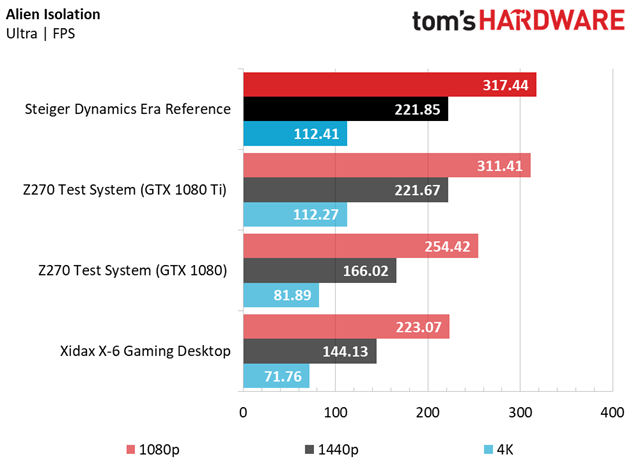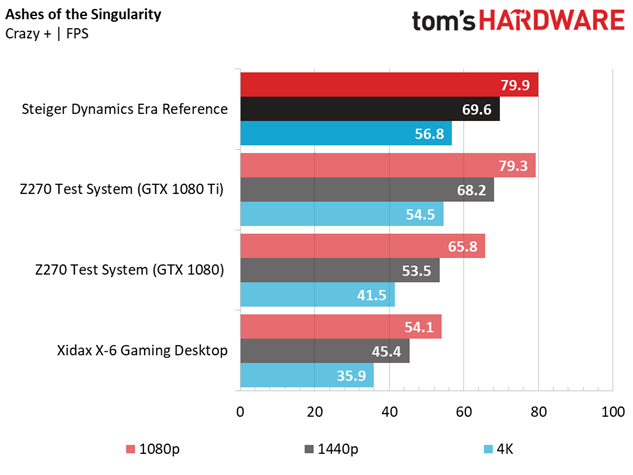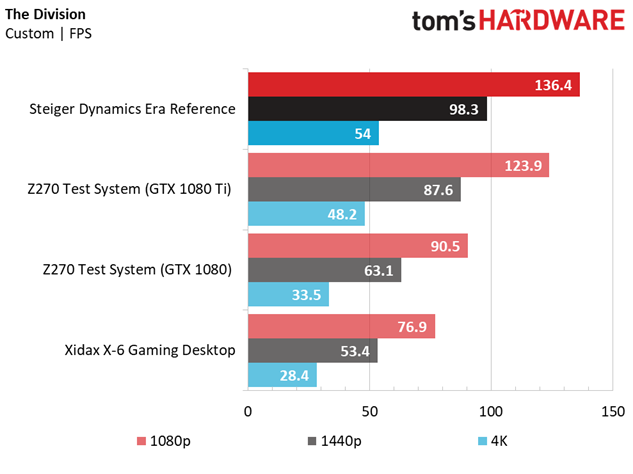Steiger Dynamics Era Reference Desktop Review
Why you can trust Tom's Hardware
Gaming Benchmarks
Alien: Isolation
The Steiger Dynamics Era Reference gaming PC kicks off the gaming benchmarks with high marks in the Alien: Isolation tests. It maintains a slight lead over our reference-clocked GTX 1080 Ti test rig thanks to its overclocked GPU (the cards are identical otherwise), and it’s clear that the game favors graphics performance. Cranked to the highest settings, Alien isn’t a problem for even GTX 1070 equipped PCs (the Xidax X-6) at 3840 x 2160.
Ashes of the Singularity
The Era Reference again edges out our GTX 1080 Ti test bed in Ashes of the Singularity, however, the difference in performance is minimal, and the overclock nets an extra 2.3 FPS (average) at most, which would be near impossible to see with the naked eye.
Bioshock Infinite
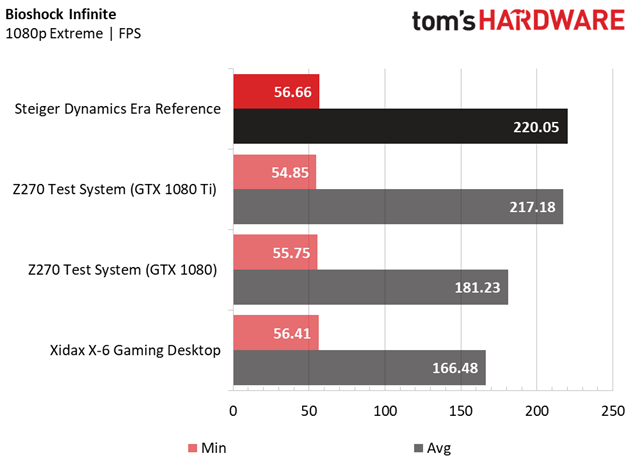
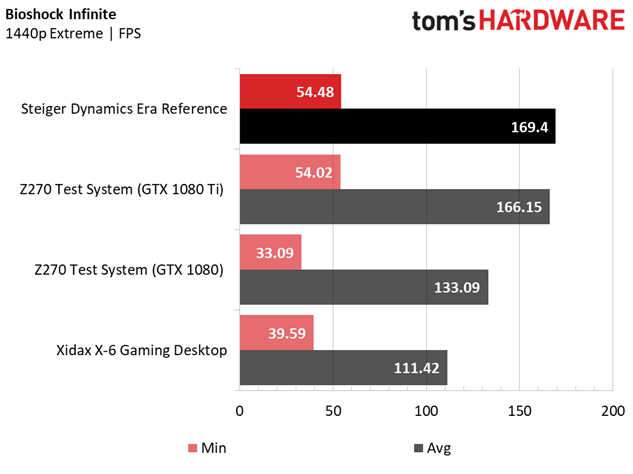
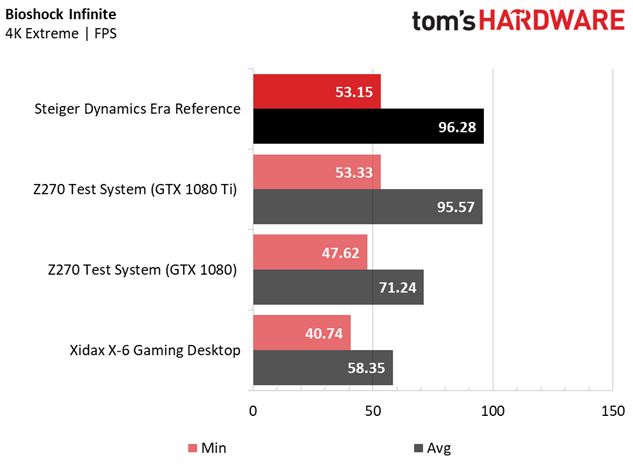
Bioshock Infinite is another game that doesn’t demand much horsepower at high resolutions, so the GTX 1080 Ti-equipped Era Reference easily takes the lead against the other PCs in the field. However, it only bests our reference GTX 1080 Ti by less than 3 FPS at all tested resolutions, and the overclocked components of the Era don’t appear to offer much of a performance gain in this particular game.
DiRT Rally
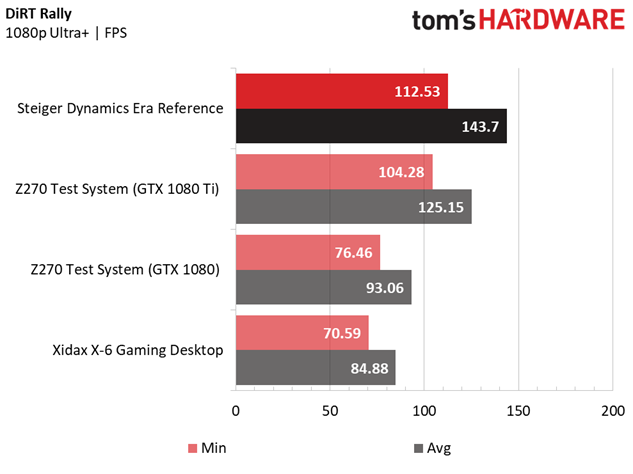

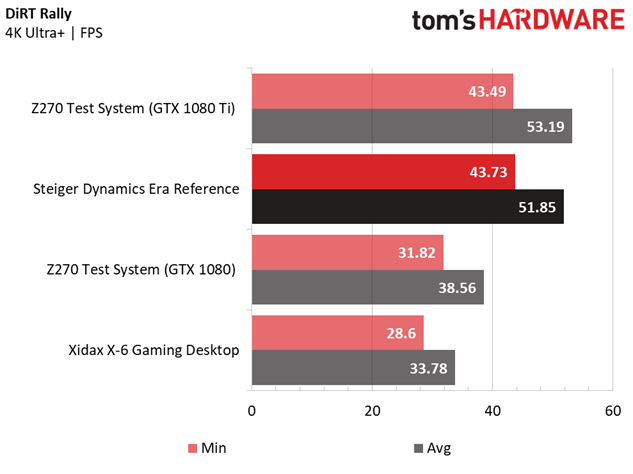
The Steiger Dynamics Era Reference starts off the DiRT Rally tests with a sizable lead against our GTX 1080 Ti test rig at 1920 x 1080 thanks to its beefy CPU and GPU overclock. However, this game prefers a more well-balanced platform, and pushing the resolution higher with our settings puts more stress on the processor, and hyperthreading quickly becomes an advantage over clock rates at higher resolutions. This forces the Era into a second-place position at 2560 x 1440 and 3840 x 2160, trailing the test rig by no more than 2 FPS.
Grand Theft Auto V
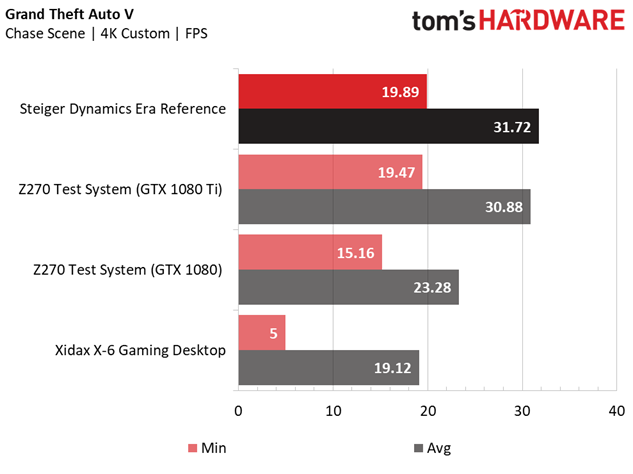
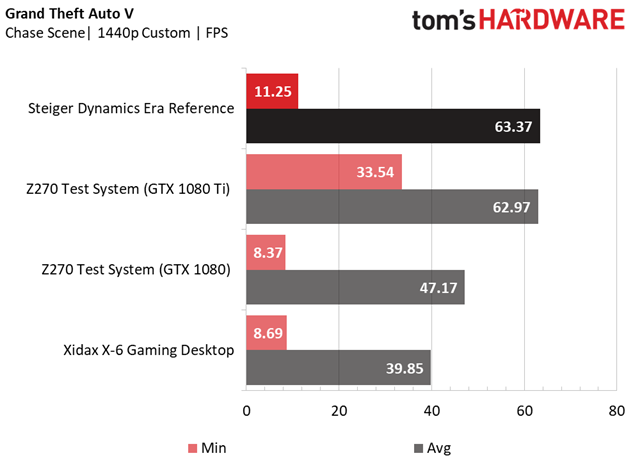
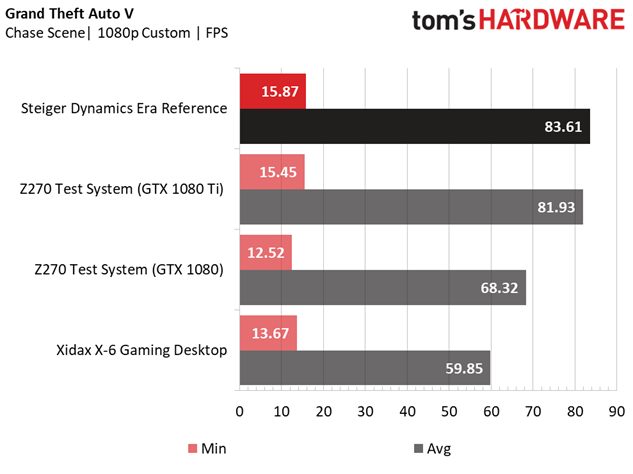
The Era returns to its usual glory at the top of the chart in GTAV, where it manages to edge out our test rig’s GTX 1080 Ti by less than 1 FPS at 2560 x 1440 and 3840 x 2160. At 1080p, this lead is slightly less than 2 FPS, and it appears overclocking doesn’t provide much of a performance boost. However, a win is a win.
GRID Autosport
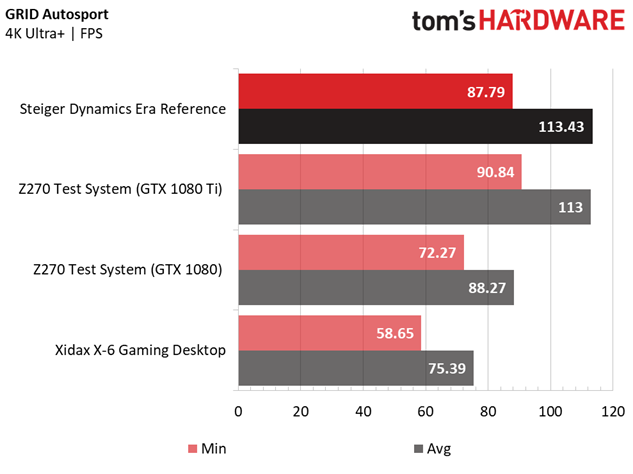

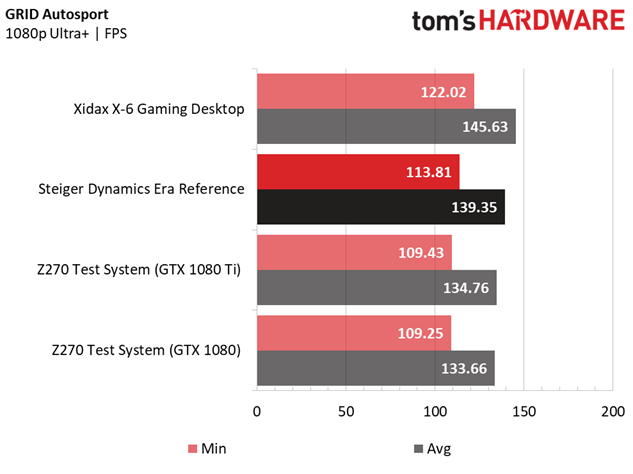
At 1920 x 1080, the Era Reference falls noticeably behind the GTX 1070-equipped Xidax X-6. This is because the CPU is the bottleneck at 1080p, and the X-6’s overclocked and hyperthreaded cores provide much higher framerate minumums, resulting in better averages than the Era and our reference-clocked test rig, despite their faster GPUs. However, turning up the resolution restores the proper GPU hierarchy, with the X-6 back on the bottom and the Era Reference back at the top. The performance gap between all of the systems is minimal at 2560 x 1440 (the CPU is still playing a factor with framerates this high), but when we push it up to 4K the graphics card dictates the pecking order.
Hitman

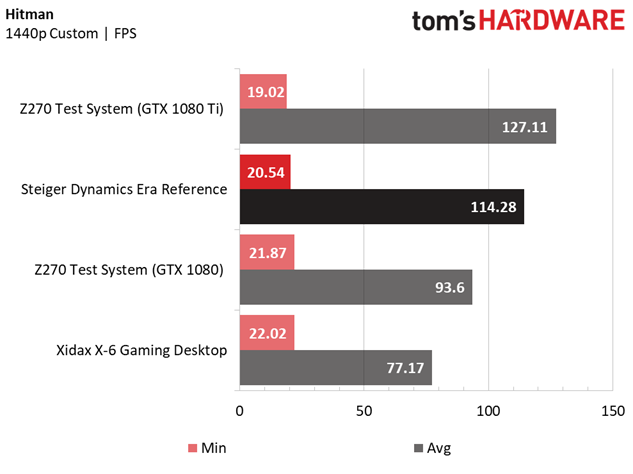
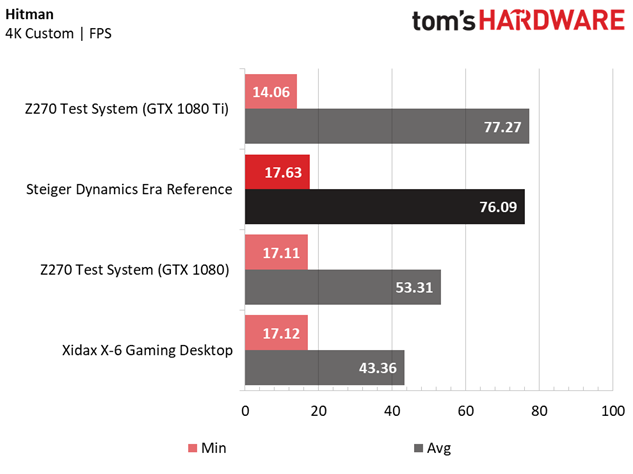
Using the DX12 API in Hitman shifts the bottleneck to the CPU, evidenced by the Era’s performance at 1920 x 1080. It barely beats out our test rig with a GTX 1080 inside, and it falls significantly behind a Core i7-7700K and GTX 1080 Ti. Increasing the resolution irons out these performance gaps, with the Era increasing its lead against our GTX 1080 test bench and gaining on the GTX 1080 Ti. However, even at 4K, the Era’s Core i5-7600K holds it back from the top of the heap, although it’s by less than 1 FPS.
Get Tom's Hardware's best news and in-depth reviews, straight to your inbox.
Metro: Last Light Redux
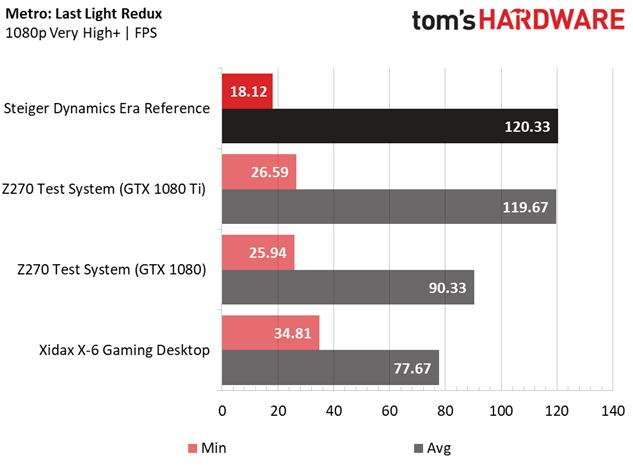
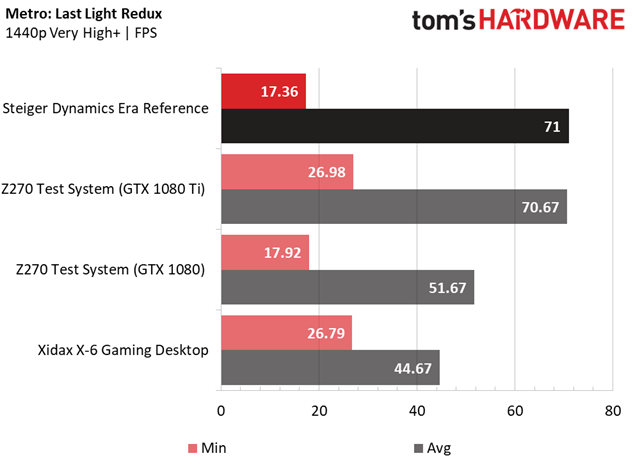
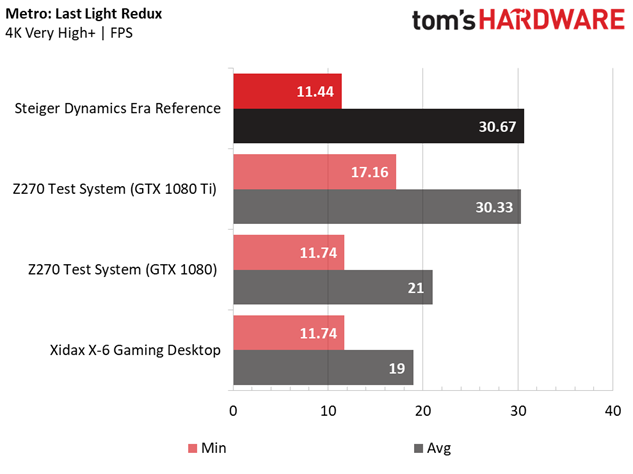
Switching back to a GPU-intensive workload, the Era Reference makes a comeback and manages to upend our GTX 1080 Ti test rig at all tested resolutions in Metro: Last Light Redux. The overclocking gains aren’t sizable at these settings (SMAA adds a significant performance overhead), and although the Era achieves the best average FPS at all tested resolutions, you can see the Core i5-7600K’s impact on performance with the Era netting the worst minimum FPS in the bunch.
Rise of the Tomb Raider
The Era’s average framerates in Rise of the Tomb Raider are a reflection of the GPU overclock, which puts it above our GTX 1080 Ti reference system at all tested resolutions. These gains are less than 1 FPS each, with ROTR demanding some serious horsepower at its highest settings (even a GTX 1080 Ti nets a sub-30 FPS average at 4K).
The Division
Unlike Hitman, The Division and its DX12 benchmark don’t appear to favor hyperthreaded CPUs, with the Era Reference overpowering our GTX 1080 Ti test rig at all tested resolutions. These gains are more pronounced at 1920 x 1080, where the Era leads the Z270 test system by a 12.5 FPS. At 4K, there is only a 5.8 FPS difference in average framerate performance, but that turns out to be a 12% gain over our test rig.
Thief
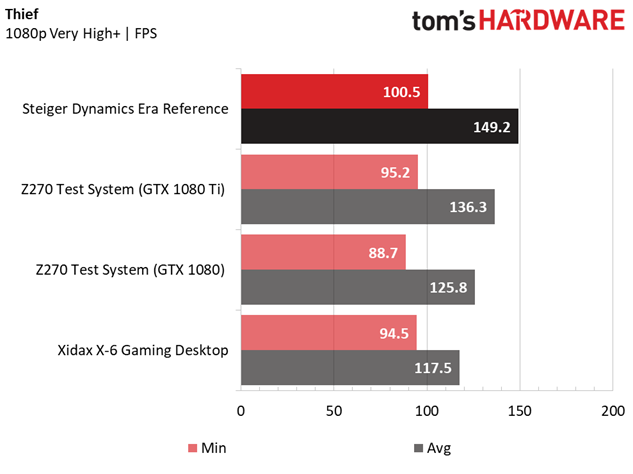
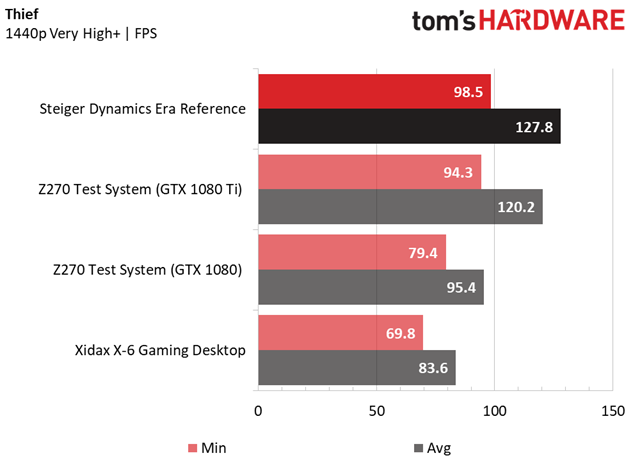
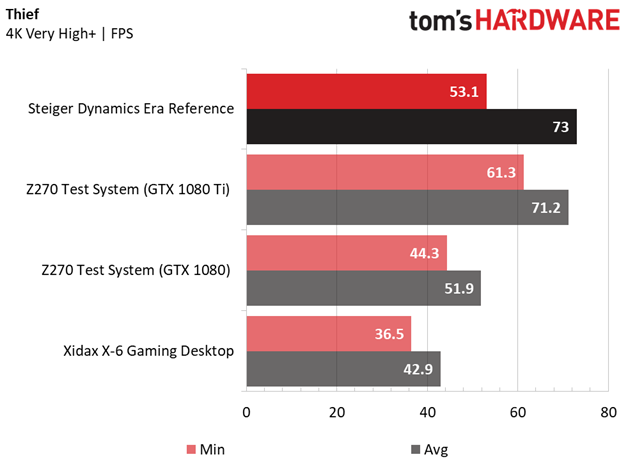
The Steiger Dynamics Era Reference finishes our benchmark suite at the top of the class, with the best average and minimum framerates at all tested resolutions in Thief. Similar to other older titles, we don’t see hyperthreading play a role in performance, so the Era’s Core i5-7600K excels with its 4.8 GHz CPU and 120 MHz GPU overclocks.
MORE: Best PC Builds
MORE: How To Build A PC
MORE: All PC Builds Content
Current page: Gaming Benchmarks
Prev Page Synthetic & Productivity Benchmarks Next Page Price Analysis & ConclusionDerek Forrest was a contributing freelance writer for Tom's Hardware. He covered hardware news and reviews, focusing on gaming desktops and laptops.
-
sargentchimera I'm generally one willing to pay extra for convenience, style, and interesting or even gimmicky features, but this is priced far too high. My system outperforms it on every level and is only worth around $1500, with nearly half of that being the 1080ti. I've bought from boutiques before I started building my own but this feels far higher than normal.Reply -
Rob1C It's 2x too expensive.Reply
Better off with something like the Asrock H110-STX MXM micro-STX Motherboard and a suitable case.
That can take an MXM Mobile PCIe Graphics Card (like Laptops use) and up to an i7. -
e-z e Always love seeing Steiger builds, if I had the resources that's the way I'd do it. Wish you guys had grabbed a few temperature measurements along the way. SFF and OC can be tricky on air.Reply -
the nerd 389 It certainly would have been nice if you'd measured the sound pressure/power level of the unit. It's supposed to be a key selling point of this model, and yet there's no attempt to test the claim that it's quiet.Reply
With other types of products that place an emphasis on acoustics, you tend to encounter a trend where the price of a product doubles for every 6-10 dB reduction in noise. (After a certain point, of course. The first 10-15 dB of reduction tends to be pretty cheap compared to the rest of a product.) That could have justified the otherwise ludicrous price they're asking for.
That strikes me as pretty unusual for a Tom's review. I expect more from you guys. -
Giroro What is with the ridiculous HDMI cable hanging out the back of the case? is that some kind of joke, or does their front HDMI panel seriously work that way?Reply -
Sarreq Teryx For all the style points on the exterior, I have to take away a ton of brownie point for that interior, and all those $49 each "extras" mentioned should be standard. It looks totally messy and unprofessional, and certainly not worthy of "Premium" or "Reference". You're paying for the brand name, rather than a good system.Reply
And I don't mean from an aesthetics standpoint, either. That GPU is half out of it's PCIe slot, and doesn't seem to be screwed in, from the pics. those cables could have easily have been customized, AT LEAST in length, if not going further by using smaller gauge silicone insulated cables, and maybe custom reduced size ATX connectors to better fit into the case (seeming the reason the GPU is crooked). They could have used a custom SFF or server PSU as well. This just looks lazy. -
Brian_R170 Not including the case, it looks like around $1500 in parts at prices an individual consumer would pay. Typical consumer-electronics retail prices are 2x the BOM cost, so a price of $3K might seem expensive, but it isn't really out of line.Reply -
islane That recessed, half-covered, crooked (!) GPU mounting is inexcusable at this price. I'm not the target audience for this, but I think even someone who isn't a DIY builder could look at this and see that something isn't right.Reply
